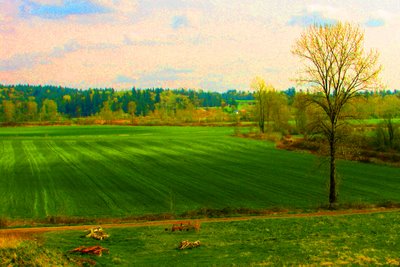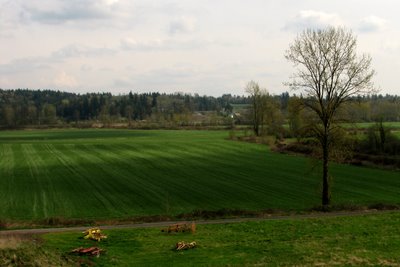Does this count?

I took this picture in Fort Langley a couple of days ago. I was disappointed with the fact that the sky was washed out, so I was trying to find a way to improve it. I had tried several different approaches, including isolating the sky, but found that I am not skilled enough with Photoshop to obtain the results I was hoping for. In a moment of frustration, I boosted the saturation on the entire image by a factor of 100%. The above picture was the result. I thought it was kind of neat, so I figured I would share it with you.
Below, I have included the original photo. As I said, I am satisfied with the composition, but the sky seemed mildly overexposed. This photography thing is hard, but I'm determined to figure it out. Thanks to the famous Uncle Robert (you should taste his Port) for all his help!

If you haven't seen yesterdays picture, please take a moment to check it out. Several people have commented that they cannot detect the noise. This is due to the limited resolution. When seen at a higher resolution, the picture is quite grainy. Someone told me that I should reduce the noise one channel at a time. I tried that, but I don't have the technique figured out very well. Thanks for all your feedback and suggestions.


15 Comments:
It's difficult these days to shoot nice photos when you have a "light grey" sky like you have there. The first version you posted somehow looked like a painting with really bright colors to me. Didn't seem like a photo anymore... Funny how this can change.
Interesting result...almost looks like a photo of a painting. I usually desaturate my washed out shots to make them presentable! :o)
Another possibility is to convert it to black and white (or maybe you tried that).
Neat-o :D
[And I agree with Dave] the first thing I thought when I came to your page was 'that looks like a painting.' I like it a lot :)
~K
The top one looks a bit like a painting now, I have the same problems with bright cloudy days.
Thats when I go to b&W! :)
On days like that it's hard to get a good sky. I fought with the same thing yesterday.
I find that spot metering and using the automatic exposure lock helps a lot with the overall exposure, then you have more to work with. Play around with the spot metering and exposure lock and you will likely see the difference. You can also use exposure compensation to try and balance it a bit more. These things don't always do the trick but I find they can help.
The other thing I use is a polarizing filter which also helps. I don't have a graduated neutral density filter yet, but from what I understand, they really make a difference in these situations.
When all else fails...Black and White!
The top one does look a lot like a painting.
I think it works well. It's a very expressive photo now! The color really gives it a warm feeling.
What are your image taking conditions? ( f, iso etc.) I wonder if having a neutral density filter would help here; It just reduces light, so that you can take long exposure in daylight.
emre said it right. A filter (both real of the one in PS) can really help with the colour of the sky (or for anything else that you might want. Check out this and this. The sky in these shots was not as it was in the picture. But applying the filters got me some good results. I know these are not prime examples of filter use, but they are what I could come up with in a short time.
You did beautiful work, looks like a painting. Nicely done.
I must admit the processed photo catches the eye!! I love the drive from Vancouver to Hope. The rich fields of the Fraser valley are verdant and abundant. Thanks for bringing back a happy memory.
I like both pictures. I believe you are improving with each adventure you're taking. The pictures are great. I have found them exciting with new concepts of adventure. It would be great to be in BC again instead of Ontario. These pictures remind me of my four years living in the Langley area. Keep up the good work.
enlarge it and tell everyone it's an original landscape by Rembrandt. :)
Perhaps you tried this already, but you can add a gradient to the sky in Photoshop so that it will be darker without darkening the ground. Here's a tutorial on the technique. If that doesn't work for you maybe adding blue like in this tutorial would work. Good luck!
There is also a way to use layers by putting the photo into layers twice and then exposing one for the sky and the other for the foreground. When they are merged, the result is more pleasing. Unfortunately, I have only done this once when I had a book that explained the technique, and I can't recall all the steps. (Sorry if this is not a lot of help, but I though you might like to know the nature of the technique even if I can't adequately explain it.)
Keep up the good work. You will be able to look back at these photos in the not too distant future and measure your progress (my own web site documents my own version of the same quest to improve that you are following)
Post a Comment
<< Home